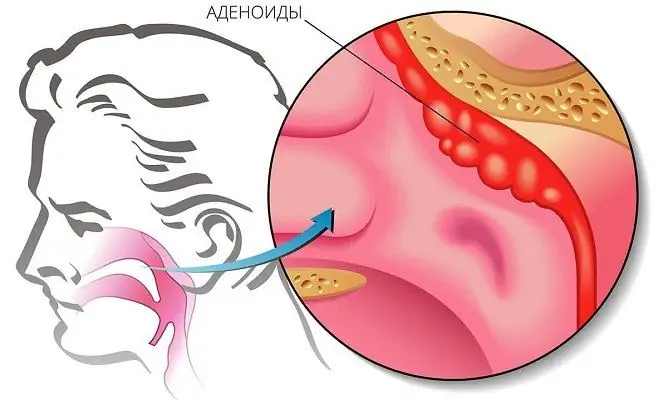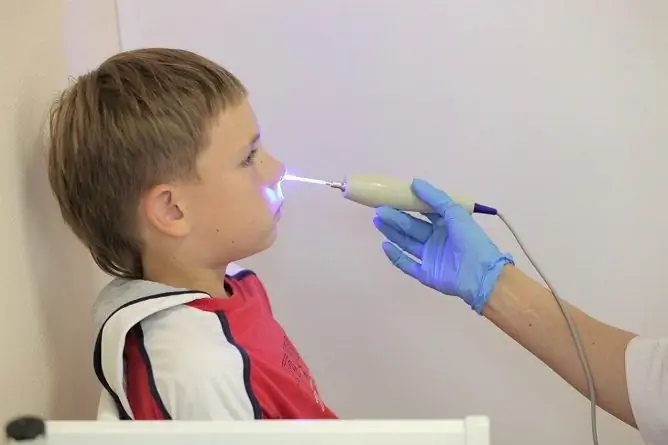- Author Rachel Wainwright [email protected].
- Public 2023-12-15 07:39.
- Last modified 2025-11-02 20:14.
Thuja oil for adenoids for children: reviews, application scheme, effectiveness
The content of the article:
- Thuja oil and its action
- How to use thuja oil, indications and contraindications
- When to expect the effect of thuja oil
- Other treatments for adenoids in children
- Overview of Adenoids
- Video
Thuja oil for adenoids for children is a safe and effective drug recommended by many doctors. Despite this, before starting therapy, it is necessary to study the features of the use of this agent and consult a pediatrician.
Adenoids (adenoid growths, adenoid vegetations) are a common disease in pediatric otorhinolaryngology. Its first stages are often asymptomatic, and do not attract the attention of parents, meanwhile, it is at an early stage that the treatment of adenoids with herbal preparations is most effective. In the later stages, herbal remedies can also be used, but they play only an auxiliary role.

Thuja oil has a vasoconstrictor and anti-inflammatory effect
According to the pediatrician E. O. Komarovsky, thuja oil can help cure adenoids, provided timely and regular use. According to some reports, thuja oil for grade 1 and 2 adenoids in children is effective in about 70% of cases, helping to cure the patient without surgery.
Thuja oil and its action
The effect of using thuja oil is due to its vasoconstrictor and antiseptic effect. Thus, the local application of this drug ensures the elimination of edema and a decrease in hypertrophy (vasoconstrictor effect), due to which normal nasal breathing is restored, and the debridement of the inflammatory focus (antiseptic effect), which helps to reduce inflammation. In addition, the agent is classified as a natural immunostimulant, that is, drugs that help strengthen the protective properties of tissues at the site of application.
It should be borne in mind that 100% thuja essential oil is not used in medical practice, since when applied topically it causes a burn of the mucous membrane. They use 15% thuja oil (15% thuja essential oil + 85% neutral solvent), this concentration is quite enough to achieve a therapeutic effect. Thuja oil sold in pharmacies is also a 15% drug.
The homeopathic pharmacy drug thuja Edas 801 oil for adenoids is one of the most popular remedies for the treatment of adenoids. Available in 25 ml vials. The drug reduces inflammation, improves metabolic processes in tissues, removes mucus. According to reviews, Edas 801 for adenoids in children can achieve a significant reduction in lymphoid tissue hypertrophy, but requires long-term and regular use.
How to use thuja oil, indications and contraindications
In addition to grade 1-2 adenoids and adenoiditis (inflammation of the adenoids), indications for the local use of thuja oil are otitis media, stomatitis, periodontal disease, rhinitis, acne, condylomas, warts, as well as arthritis and arthrosis.
How to drip the drug? In accordance with the instructions, thuja oil for adenoids for children and is used intranasally - it is necessary to instill the drug 3-4 drops in each nostril 2-3 times a day. In practice, the scheme of application and the duration of the course are selected by the attending physician individually, taking into account the characteristics of each child. On average, treatment lasts 4-6 weeks, then, after a week's break, the course is repeated.
Usually, the use of thuja oil is recommended to be combined with rinsing the nose with saline solutions - first, the nose is washed, then oil is instilled into each nostril. It should be borne in mind that rinsing the nose should not be carried out before going outside. In the warm season, at least half an hour should pass before leaving the house, and in the cold season - 1-2 hours.
Thuja oil can be part of complex therapy, as it is compatible with any pharmacological preparations.
The advantage of thuja oil is its safety and minimum side effects. Contraindications to its use are only the child's susceptibility to allergies and individual intolerance to the components of the drug.

Homeopathic medicine EDAS 801 is a 15% thuja oil
To avoid a possible allergic reaction, a test should be carried out before using the medication - apply 1-2 drops of thuja oil on the skin of the forearm and check the skin reaction after 20 minutes. If there is no reaction, the drug can be used if the skin at the site of application turns red or becomes covered with a rash, then the thuja oil is prohibited for this patient.
When to expect the effect of thuja oil
Often parents ask how long it will take to get the effect of thuja oil. There are no clearly set deadlines. The organism of each child is also individual, and the conditions in which he undergoes treatment, and the degree of proliferation of adenoid tissue.
Experience shows that treatment with thuja oil is especially effective for grade 1 adenoids, in which case it takes 1 to 3 months. At stage 2, as a rule, one thuja oil is no longer enough; it is used in combination with other means and methods. The effect of the use of thuja oil for grade 3 adenoids can not be expected at all - in this case, there is often a need for surgical treatment. In any case, treatment with thuja oil should be supervised by an otolaryngologist, so that in case of ineffectiveness, the therapy can be adjusted in time by connecting other methods.
Other treatments for adenoids in children
In the early stages, the treatment of adenoids is usually carried out conservatively; at an advanced stage, it may be necessary to remove the adenoids by surgery or using alternative methods.
Conservative therapy usually includes the use of anti-inflammatory, decongestant, antihistamines, rinsing the nasal cavity with saline and antiseptic solutions, physiotherapy procedures (laser therapy, ozone therapy, ultra-high-frequency therapy, inhalation, electrophoresis).
If a bacterial infection is found in the contents of the nose, antibacterial drugs are prescribed.
Surgical treatment of adenoids (adenotomy), which some time ago was considered necessary at any stage of the disease, is not a guarantee of a complete cure, since relapses are possible. The modern approach is to prescribe surgery only if there are strict indications.
Indications for adenotomy include: ineffectiveness of conservative therapy, prolonged absence of nasal breathing, hearing impairment, recurrent otitis media, sinusitis, changes in the child's facial skeleton (formation of an "adenoid" face type), mental and physical lag due to chronic hypoxia.
Spa treatment is indicated for children with adenoids.
Overview of Adenoids
Adenoids represent a pathologically enlarged nasopharyngeal tonsil. Normally, this is a small node of lymphoid tissue, whose task is to clean the air entering the respiratory tract from potentially dangerous agents for the body (dust, bacteria, etc.).
There are three degrees of adenoid vegetation:
- The patient has a slight disturbance in nasal breathing, this is especially noticeable when he sleeps on his back (puffing or snoring during sleep); sleep disturbances, irritability, and susceptibility to respiratory infections may occur.
- Violation of breathing through the nose becomes more pronounced, discharge from the nose of a mucous or purulent nature is observed, mucus can drain along the back wall of the nasopharynx, causing a reflex cough, snoring and noisy breathing constantly accompany a night's sleep.
- Nasal breathing is absent, the patient breathes through the mouth, which is why the mouth is constantly open, an adenoid type of face is formed, the child often suffers from ENT diseases, hearing may decrease, nasal sounds and other numerous complications may appear.
In the absence of nasal breathing, the body loses about 20% oxygen, which leads to the development of headaches, dizziness, fatigue, pallor of the skin, and deterioration of cognitive abilities. In children, against the background of neglected adenoids, there may be a lag in mental and physical development.

In the late stage of the adenoids, soft herbal remedies are ineffective, removal of growths is indicated
In some cases, patients with adenoids may experience asthma attacks during night sleep (sleep apnea) caused by the retraction of the tongue root when the lower jaw drops, if the patient breathes through the mouth. Often, these children suffer from bedwetting.
In the absence of treatment, adenoid vegetations are a source of constant infection in the body, which can lead to infectious damage to the cardiovascular, urinary system of the gastrointestinal tract.
Therefore, it is extremely important to start the treatment of adenoids on time and carry it out correctly, under the supervision of a doctor.
Video
We offer for viewing a video on the topic of the article.

Anna Kozlova Medical journalist About the author
Education: Rostov State Medical University, specialty "General Medicine".
Found a mistake in the text? Select it and press Ctrl + Enter.






